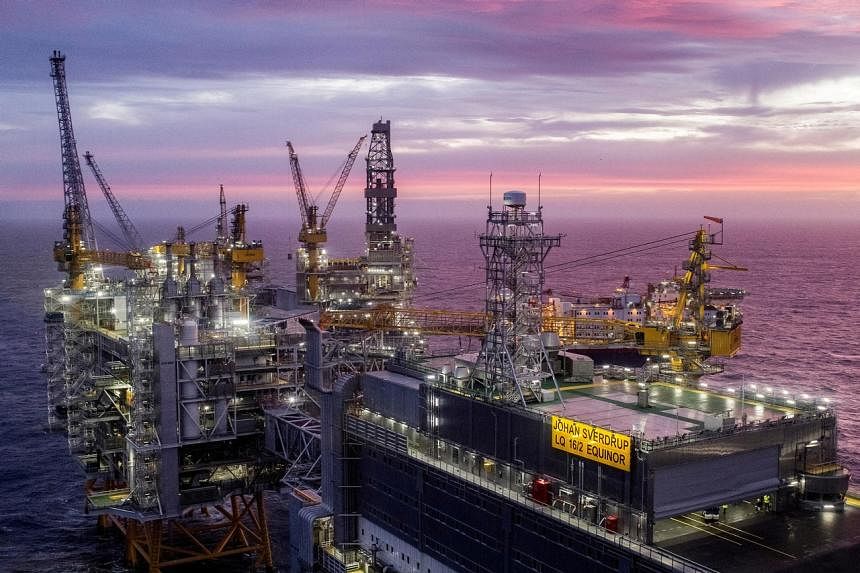SINGAPORE - Rising energy and electricity prices worldwide have cast a spotlight on international energy markets.
Much of the price increase is linked to stinging sanctions on Russia's oil and gas exports following its invasion of Ukraine in late February.
This has caused severe disruptions to supply lines into Europe, with the impact reverberating globally as the region scours the world for alternative supplies.
The Straits Times explains some of the common terms used in media reports.
Brent/WTI
Global oil markets commonly use two benchmarks: the West Texas Intermediate (WTI) and Brent.
The Brent crude benchmark is used to buy and sell more than three-quarters of the world's traded oil, and is one of the most liquid crude grades.
Physical oil traders prefer the Brent benchmark as they believe it more accurately reflects global supply and demand balances.
The Brent benchmark is made up of crude mostly drilled from the North Sea oilfields. It is traded widely because of the ease of transporting the oil on ships globally.
Brent crude oil futures are primarily traded on the United States-headquartered Intercontinental Exchange's electronic trading platform.
WTI is a blend of several US domestic crudes that are low in sulphur.
It is drilled and processed in the US, and mostly refined in the Midwest and on the Gulf Coast. WTI is mainly used as a benchmark in the US oil market.
As the contract is made up of crude mostly from inland US, there is restricted access to shipping ports and world transport links.
Futures contract
A futures contract or futures is a legally binding agreement to buy or sell an asset, such as oil, at a predetermined price on a specific expiry date.
The buyer of a futures contract is obligated to receive the asset on the specified date, while the seller is required to part with it at the contracted price.
Futures contracts are traded on exchanges. In the case of oil, these contracts are traded on the New York Mercantile Exchange and Intercontinental Exchange.
The contracts are highly regulated and standardised to ensure the uniform quality and quantity of each contract.
Futures are commonly associated with commodities trading.
Spot market
The term "spot market" is used to refer to an asset that is traded for immediate delivery.
In the case of energy products such as liquefied natural gas (LNG), crude oil, gasoline and gas oil, the bulk of globally traded volumes are done via structured long-term contracts that can range from three months to multiple years.
However, most of these longer-term contracts rely on the spot market for their pricing. This is usually determined on a structured basis, which refers to a formula agreed upon by both the buyer and seller.
While spot market trades can be considered to be one-off deals, they are still highly structured and standardised with regard to the location of the trade; and the basis by which the cargo will be transported ‒ either by ship, tanker truck, pipeline or rail tank cars. There is also a specific time period by which the deal must conclude.
Opec/Opec+
The Organisation of the Petroleum Exporting Countries (Opec) is a group of 13 oil-rich countries that together control nearly 40 per cent of the world's oil supply.
The group is sometimes referred to as a cartel because of its strong influence on global oil markets.
It is made up of Saudi Arabia, Iraq, Iran, Kuwait, Venezuela, United Arab Emirates, Algeria, Nigeria, Angola, Libya, Gabon, Equatorial Guinea and Congo.
Opec was established in 1960 to maintain stability in the oil markets by coordinating production among its members, as well as managing and setting production quotas.
The group also looks at mitigating oil price volatility to make production of oil profitable. It also manages imbalances in the market by adjusting production collectively either by reducing or adding oil supply to the market.
In 2017, an alliance of non-Opec producers, including Brunei, Kazakhstan, Malaysia and Russia, joined Opec to form Opec+.
Earlier in September, Opec+ agreed to a 100,000 barrel per day cut in October to defend oil prices from sliding further.
Price cap
The Group of Seven (G-7) nations ‒ comprising the US, Japan, Germany, Britain, France, Italy and Canada ‒ and the European Union are working to introduce a mechanism that will cap the price of Russian oil sold on the market.
The move is an attempt to limit Moscow's ability to fund its invasion of Ukraine.
Officials from the G-7 countries suggested the measure, to start on Dec 5, in an attempt to slash the money Russia earns from oil sales without actually reducing its petroleum exports to buyers across the world.
The details of the cap are still being worked out.
There are also discussions to rope in China and India, which have been the biggest buyers of oil from Russia since the war started.
Russian crude is already trading at a discount based on the Brent benchmark and the G-7 wants to further widen this discount to choke off Russian oil revenue.
The price-cap plan will include a move for countries to deny Western-dominated services, including insurance, finance, brokering and navigation, to oil cargoes priced above the cap.


